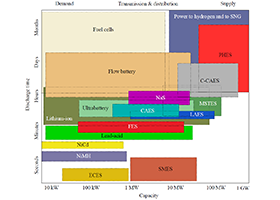Modeling, Control, Stability and Applications of Energy Storage Systems
A special issue of Energies (ISSN 1996-1073). This special issue belongs to the section "F1: Electrical Power System".
Deadline for manuscript submissions: closed (31 March 2022) | Viewed by 9934

Special Issue Editor
Interests: modeling, control and stability of energy storage systems connected to transmission and distribution systems; frequency estimation, control and stability in low-inertia systems
Special Issue Information
Dear Colleagues,
Energy storage systems are destined to be a fundamental part of power systems in their path towards a decarbonized future. This is fairly justified by their remarkable flexibility, their gradually increasing efficiency, and their sustained cost reduction. Notwithstanding skeptical reactions in their origins, the blooming of energy storage technologies other than pumped hydroelectric storage is now undeniable. However, one must recognize the fact that such energy storage systems are still in their infancy, and an important research effort needs still to be done in the years to come.
With the above in mind, this Special Issue aims at collecting the state of the art of energy storage systems in all their aspects. We encourage papers that provide technical original ideas, reviews, real-world applications, dynamic and economic analyses, and developments of existing storage technologies.
In particular, topics of interest for publication in this Special Issue include, but are not limited to:
- Conceptual design and proof-of-concept of novel energy storage technologies
- Studies of new applications of energy storage systems
- EMT and RMS modeling of storage devices and power-electronics converters
- Aggregated modeling and operation of distributed energy storage systems and electric vehicle fleets
- Operation and economic modeling of energy storage systems
- Harmonic analysis and dynamic couplings of converter-interfaced energy storage systems
- Design of novel/improvement of existing control techniques for energy storage systems
- Small-signal, transient, frequency, voltage and/or converter-driven stability analysis of energy storage systems
- Demonstrations of real-word energy storage systems
- Updated, detailed reviews of techno-economic aspects of energy storage systems
- Economic analysis and viability of energy storage systems
- Electricity and ancillary services market participation of energy storage systems
Dr. Álvaro Ortega Manjavacas
Guest Editor
Manuscript Submission Information
Manuscripts should be submitted online at www.mdpi.com by registering and logging in to this website. Once you are registered, click here to go to the submission form. Manuscripts can be submitted until the deadline. All submissions that pass pre-check are peer-reviewed. Accepted papers will be published continuously in the journal (as soon as accepted) and will be listed together on the special issue website. Research articles, review articles as well as short communications are invited. For planned papers, a title and short abstract (about 100 words) can be sent to the Editorial Office for announcement on this website.
Submitted manuscripts should not have been published previously, nor be under consideration for publication elsewhere (except conference proceedings papers). All manuscripts are thoroughly refereed through a single-blind peer-review process. A guide for authors and other relevant information for submission of manuscripts is available on the Instructions for Authors page. Energies is an international peer-reviewed open access semimonthly journal published by MDPI.
Please visit the Instructions for Authors page before submitting a manuscript. The Article Processing Charge (APC) for publication in this open access journal is 2600 CHF (Swiss Francs). Submitted papers should be well formatted and use good English. Authors may use MDPI's English editing service prior to publication or during author revisions.
Keywords
- Ancillary services
- Battery energy storage
- Distributed energy resources
- Dynamic modeling
- Electric vehicles
- Electrochemical energy storage
- Elecromagnetic energy storage
- Energy storage systems
- Low-inertia systems
- Mechanical energy storage
- Power system control
- Power system reliability
- Renewable energy sources
- Stability analysis
- Thermal energy storage
- Voltage-sourced converters





